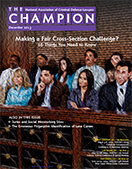December 2013

Every criminal defendant tried by a jury has the right to have that jury selected from a fair cross-section of the community. Defense attorneys can raise a fair cross-section claim under the Sixth Amendment, state constitutions and statutes, and the Jury Selection and Service Act.
Articles in this Issue
-
A Lamentable Example of Overcriminalization: HIV Criminalization (Inside NACDL)
Dozens of states have criminal statutes specific to HIV, others use existing statutes to prosecute people who commit certain crimes when they are HIV positive. Many of these laws are the product of hysterical overreaction, lacking any nexus to the actual risk of transmission.
-
Affiliate News
John T. Rodgers, a former Washington Association of Criminal Defense Lawyers (WACDL) board member, has been appointed to serve as a magistrate judge for the U.S. District Court for the Eastern District of Washington.
-
Book Review: Yardbird USA: How the United States Became The World’s Leading Jailer
Yardbird USA is a satirical look into the policy of the United States on incarceration. Jack Cline uses the Pennsylvania criminal justice system and its sentencing scheme as an example of the problems faced by the nation.
-
From the President: Dispense With the Presumption Of Pretrial Detention
Pretrial detention for people who don't need to be detained is foolish and financially wasteful. Through NACDL's Pretrial Release Advocacy Project, NACDL will develop and distribute legal and practical resources so that current knowledge is accessible to practitioners to aid in challenging pretrial detention and bail determinations.
-
Indigent Defense
Assistant public defenders have it really tough in the trial courtrooms. These lawyers are typically assigned to large caseloads in which surprises can arise at any time, even when meeting the client for the first time. First meetings can be very tense, and a lawyer must possess the required skills to resolve the tension and seek a favorable solution for the client.
-
Juries and Social Networking Sites
Social media is a mainstay in daily life. Over a billion people are registered users of Facebook. The Facebook logo and the logos of other social networking giants such as Twitter are quickly becoming as iconic as McDonald’s Golden Arches or Apple’s apple. As the popularity of social networking sites grew, industries scrambled to utilize such a powerful tool. The legal profession is no exception. Unfortunately, the combination of rapidly changing technology and slowly evolving law has created a potpourri of law in which little is settled or clear when it comes to social media and the courtroom. What is clear, however, is that attorneys who understand how social media can help or hurt their clients and have well-defined plans for tackling social media issues will be in the best position to successfully advocate for their clients.
-
NACDL News: Congressional Task Force on Overcriminalization Holds Hearings on Regulatory Offenses
The Congressional Task Force on Overcriminalization, which was created on May 7, 2013, by a unanimous vote of the House Committee on the Judiciary, held its third hearing on Oct. 30, 2013. The task force — composed of five Democrats and five Republicans — has been charged to “conduct hearings and investigations and issue a report on overcriminalization in the federal code, as well as possible solutions.”
-
NACDL News: NACDL Offers Two NSA-Related Litigation Strategy Webinars
On Oct. 31, 2013, NACDL presented a live webcast featuring a panel discussion with Joshua Dratel and Barry J. Pollack — “How to Challenge NSA Terrorism Spying in Nonterrorism Cases: A Primer on the NSA/DEA Special Operations Division Information Sharing Program.”
-
NACDL News: NACDL’s Shana Regon Discusses Overcriminalization at ABA Criminal Justice Institute
On Oct. 31, NACDL Director of White Collar Crime Policy Shana-Tara Regon spoke on a panel entitled “Fixing a Broken System: An Update on the Work of the Bipartisan House Judiciary Task Force on Overcriminalization” at the ABA’s Criminal Justice Section’s Sixth Annual Fall Institute on Sentencing, Re-entry, Juvenile Justice and Academics in Washington, D.C.
-
NACDL News: NACDL’s Task Force on Federal Indigent Defense Convenes Inaugural Meeting
The newly established NACDL Task Force on Federal Indigent Defense held its first meeting Nov. 25 at the association’s headquarters in Washington, D.C.
-
NACDL News: Racial and Ethnic Disparities in the Criminal Justice System: NACDL and Its Partners Hol
On Dec. 6, NACDL, the Foundation for Criminal Justice, and co-sponsors the Association of Prosecuting Attorneys, the Brennan Center for Justice at New York University School of Law, the Center for NuLeadership on Urban Solutions, and the New York County Lawyers’ Association, held a follow-up conference on racial and ethnic disparities in the criminal justice system.
-
The 16 Things Every Defense Attorney Should Know About Fair Cross-Section Challenges
Every criminal defendant in federal or state court who will be tried by a jury has the right to have that jury selected from a fair cross-section of the community. Every criminal defense attorney should be equipped to enforce that cross-section right when it is in the client’s best interest to do so. Part I of this article explains the 16 things a defense attorney should know about fair cross-section challenges, and Part II provides a detailed analysis of two successful fair cross-section claims.1
-
The Erroneous Fingerprint Identification Of Lana Canen
Helen Sailor, 94 years old and blind, lived at the Waterfall High Rise apartment complex for the elderly, disabled, and handicapped in Elkhart, Ind. On Nov. 28, 2002, Sailor spent Thanksgiving Day with relatives who drove her back to her apartment that evening. The next day, her home healthcare provider and two of Sailor’s relatives entered her apartment and made a terrible discovery. Helen Sailor was dead; her body had been badly beaten. The forensic pathologist ruled it a homicide with strangulation as the cause. Two years later, police filed murder charges against Lana Canen.
